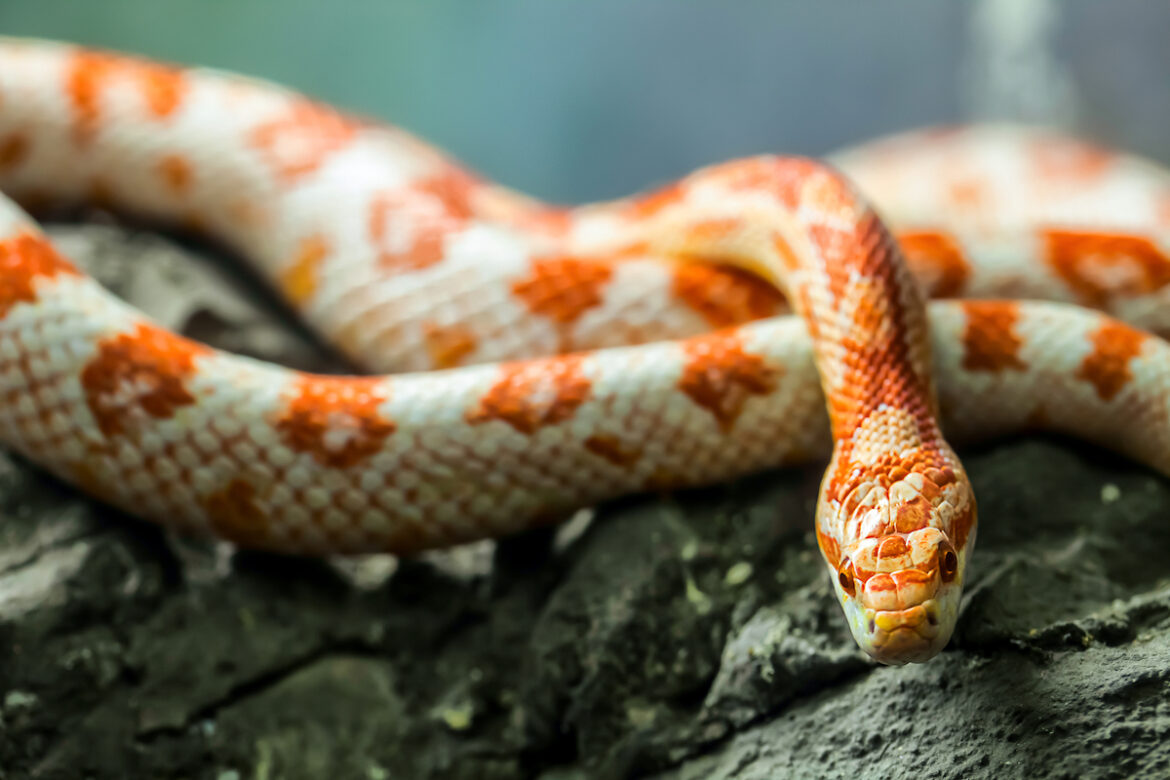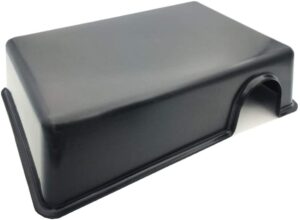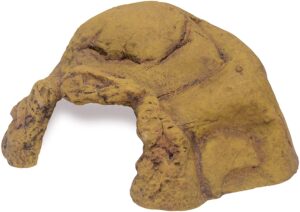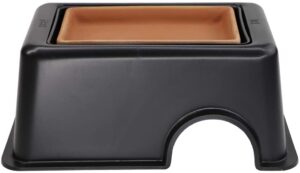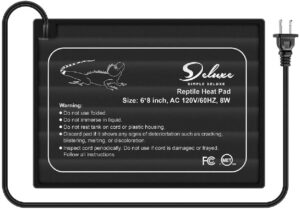Many animal lovers find themselves clueless when it comes to caring for reptiles. It’s little wonder as these are exotic pets. And that means that not only will you need to give far more attention and care for your beloved pet, you will also have to educate yourself about all of its needs.
All pets require love. But your pet serpent is no regular pet. It has distinct needs, and almost nothing about the care of snakes is similar to the needs of more warm-bodied pets. One of the biggest needs your snake has is a few nice and comfy places to hide.
So, what are the best hides for snakes? Snakes require more than one hide and each type of snake has its separate needs. Generally, snakes need at least one warm hide and one cool hide so they can regulate their body temperature. Tropical snakes and shedding snakes also may need a humid hide to keep from becoming dehydrated.
Read on to find out all there is to know about hides and the reason why your noodly friend needs them. We’ll also introduce you to some of the best hides available to buy today!
Why Do Snakes Need Hides?
No, your snake doesn’t only need a hide and a water bowl. Your pet very much requires a full habitat and even multiple hides to live a happy and healthy life. So you first have to acquire the right sized tank for your snake.
Next, you have to provide a water bowl that’s deep enough for your snake to submerge itself in for hydration but not so deep that it can’t reach the bottom.
You’ll also want at least two hides, one on each end of the tank. One of these hides should be heated with something like a heating pad that sticks to the outside of the bottom of the tank. You’ll also need a heat lamp to maintain the ambient temperature in your tank. Some snakes require hotter temperatures than others.
Don’t underestimate the importance of a heat source for your snake, as they are cold-blooded and cannot produce body heat on their own. If left too cold for too long, your snake will suffer from a slowed metabolism, lethargy, digestive distress, and even death.
If your snake is a burrower, it’s important to have a substrate like leaf litter, coconut husk, etc. so they can create a cozy little den for themselves. If they are an arboreal species, make sure they have a sturdy branch or vines to climb.
Now you may wonder what a “hide” actually is, so allow us to inform you. You see, snake hides are safe spots for snakes where they can hide away from prying eyes and feel secure. It needs to be clean and dark. We’ll explain a bit more about the importance of hides below.
Why Do Snakes Need More Than One Hide?
The first and foremost reason for providing more than two hides is temperature control. Snakes sometimes need cooler places to hang out to allow their body temperature to come down. On the flip side, your snake also needs a spot that is as dark and warm so they can warm up and digest their food properly.
If your snake is tropical, it’s also a great idea to even have a third hide that’s always moist so they won’t get dehydrated and can slither in there when they need to shed. If your snake isn’t hydrated enough while shedding, they can end up with stuck pieces of skin that can pose health risks if the buildup continues.
You can keep this hide moist with the help of misters or simply spray it with filtered water a few times throughout the day.
Exotic vets recommend that you place two or more hides within a snake tank in most circumstances not only for the physical wellbeing of your snake but also for their peace of mind. And yes, snakes do get stressed out if they don’t have a hide.
There is an exception to the “two or more” rule, however, when it comes to large snakes. It can be very challenging to find a tank that’s large enough to let your snake stretch out and house multiple hides.
If you can’t build a custom enclosure, you can provide your snake with one cool hide and an open warm basking spot on the opposite side instead.
Their instincts tell them to find nice dark places to hide from predators, so if they’re constantly out in the open, they can become stressed and defensive. And dealing with a defensive snake is never fun for you, either.
Also, you have to provide your snake with some form of enrichment, and keeping more hides within a tank means more exploration time for your pet. Not to mention, snakes like their quiet time.
But, you have to understand that not all snakes are alike. Some are pretty big and less active. At the same time, others are smaller and far more adventurous.
SWhen you decide to adopt a snake, you must provide for all of its needs in the exact measure. So, let’s first discuss the differences in hides required by the different kinds of snakes.
Types of Hides
Now that you know what hides are and they’re essential for your snake’s wellbeing, we’ll discuss different types of hides and suggest a few of our favorite products to consider.
1. Large Snake Hides
When speaking of size in the reptilian world, this term can be relative. For some, a boa constrictor is their max when they think of a reasonable house pet.
But the real essence of the word ‘large’ comes into play when you speak of snakes such as the Burmese python or the reticulated python that can grow even larger in length than a Burmese python. And don’t get us started on the green anaconda.
These snakes can be 10-18 feet in length, or in some rare cases much longer, and up to 200 pounds in weight. And more people own these gorgeous giants than you’d think.
Now, if handled correctly, many of these snakes have very mild-tempered personalities. But you have to consider the size of your pet to appreciate the amount of caution and care that will be necessary when dealing with a pet of such epic proportions.
Anything larger than, say, a redtail boa will require a custom-built enclosure and hiding spots, which is one reason why the largest snakes aren’t very popular pets.
But boas that reach more reasonable lengths of 6-10 ft will require large tanks and hides that can sometimes be found in stores or on specialty sites ready for order.
Firstly, the tank has to be huge and ridiculously sturdy. And, when you speak of hides for such enormous pets, you have to consider the sturdiness of the hide itself.
Snake hides are available in all kinds of materials, from plastic to natural limestone and rock. So if you want a rather large-sized pet baby slithering around in your house inside a tank, make sure to go for the real stuff. Plastic and fiberglass don’t hold for long under the weight.
You can start by looking at the XL snake hide by Leoterra – which is perfect for boas and Burms in terms of size and weight capacity.
2. Small Snake Hides
Small snake hides are very cheap and available at most pet stores in a range of materials. Most pet parents go for the plastic and fiberglass snake hides that are easily washed, dishwasher-proof even, and have a rock or limestone finish.
Now, most small snakes, such as the corn snake, have very laid-back personalities, so your snake hides will last longer anyway, but you’ll still want something that’s nice and sturdy.
We’d recommend looking at caves like the Exo Terra Reptile Den – which are made from resin because they’re pretty easy to manage and durable to boot.
3. Humid Hides
As mentioned earlier, humidity is a must for snakes for proper skin shedding. But there are plenty of places across the globe where temperatures or altitudes can reach so high that they dehydrate your beloved pet even within your home.
So, it’s best to go for natural materials in such environments, mainly limestone and sandstone. These are rocks that are heat-resistant and retain moisture.
So even in the worst weather, you can expect a cool, moist, and dark spot for your beloved serpent. While we couldn’t locate any limestone hides, we liked the Reptile Hideout Box by Wontee for its slow-release humidifying feature. You fill the basin with reptile-safe water and the hide does the rest.
This one is meant for smaller snakes, but you can always create a humid hide for larger snakes by putting some moss or moisture-retaining natural material and spraying it down a few times a day.
4. Warm Hides
Naturally, sometimes you have to adjust the temperature of your snake tank in contrast to the weather outside. Most snakes belong in hot climates.
Now, if you want such an exotic pet in your house, you have to ensure its safety and well-being.
You have to provide warm snake hides that will keep your pet warm and toasty. In most circumstances, it isn’t the material of the snake hide that matters, but it’s best to go for a synthetic material that heats up quickly and stays warm longer.
While there aren’t any hides that warm up on their own, you can purchase a heating pad like the Reptile Heat Pad from Simple Deluxe. It sticks on the underside of the tank and warms the floor of the tank so you can place a hide over it.
5. Cool Hides
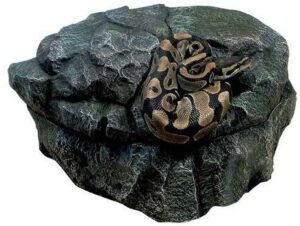
Natural rocks are the best materials to provide your snake with cool hides. Also, the more shaded the hide will be, the cooler it will be for your snake.
Now it may be apparent from your snake’s usual behavior that it likes its privacy. So piling up some dried leaves in the tank close to the snake hide will serve the dual job of providing privacy and keeping your snake cool in the summer. Make sure it’s on the opposite end of the tank from the heat lamp.
We like this Reptile Shelter from Zoo Med because of its natural look and several size options. It has a lid for easy access but will stay nice and dark for your snake. Just remember to order a larger size if you’re not sure your snake will fit.
Related Questions
Snakes aren’t popular pets. That may be true. But that is not for the reason many people would think. You see, there’s a lot of misinformation out there about snakes as pets. Some people mistakenly believe all snakes are aggressive, slimy, or dangerous.
In truth, most snakes you can have as pets, such as boas, corn snakes, and ball pythons, are quite docile and easy to handle, as long as you’re not agitating them. Snakes also feel just like any other reptile, which is to say quite dry and scaley, and not at all slimy.
This false information makes it almost impossible for people to consider adopting one of these fascinating and gorgeous animals into their lives.
Yet many animal lovers brave the unknown and discover to their immense pleasure that some snakes make fantastic pets and can even help calm anxiety much the same way a cat or dog can!
So there are plenty of first-time snake parents out there who are always in search of more answers that may help them serve their snake babies better. If you read on, you’ll find a few commonly asked questions.
Is It Necessary to Sanitize Snake Hides?
Unfortunately, snakes can give humans salmonella. But the good news is that the situation can be easily remedied. All you have to do whenever you touch your snake or clean up its tank is to wash your hands thoroughly.
As for cleaning up for the snake, you must wash the hides and the tank at least once a week. You see, the more sanitary you keep the tank, the healthier your pet is going to be. Snake waste tends to attract many fungal and bacterial infections that can seriously make your pet ill. And the best way to avoid disease is precaution and cleanliness.
For the best results, use diluted bleach or cleaning vinegar and allow it to dry before rinsing again and adding it back into the tank.
Can Natural Hides Made Of Wood And Rock Be Sanitized?
Yes, wood can actually be sanitized by bleaching it and baking it in your oven on low heat. We’ve found a handy tutorial for you by the Animals at Home channel on YouTube.
You can also just replace the wood you have with new wood from the outdoors, but be aware that wood can house all kinds of little critters, germs, and creepy-crawlies. It’s important to rid the wood of things like mites that could pose a health risk to your snake.
While this is an environmentally friendly way to renew your wood, you will still have to follow the rinsing, bleaching, and baking procedure explained in the video above.
Rocks like limestone are easier to clean but may erode a bit over time. Yet a bit of dishwashing liquid and a brush will help you clean up the snake hide well with some warm water and even bleach.
Up Next: Do Snakes Get Sad?
